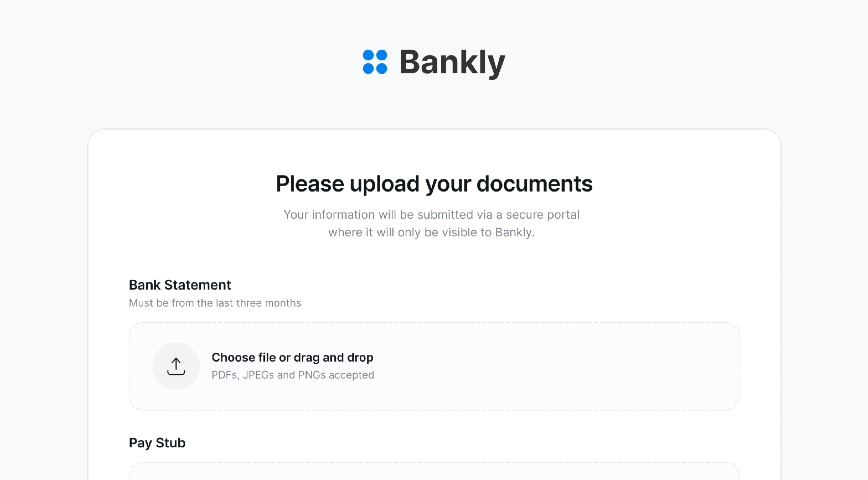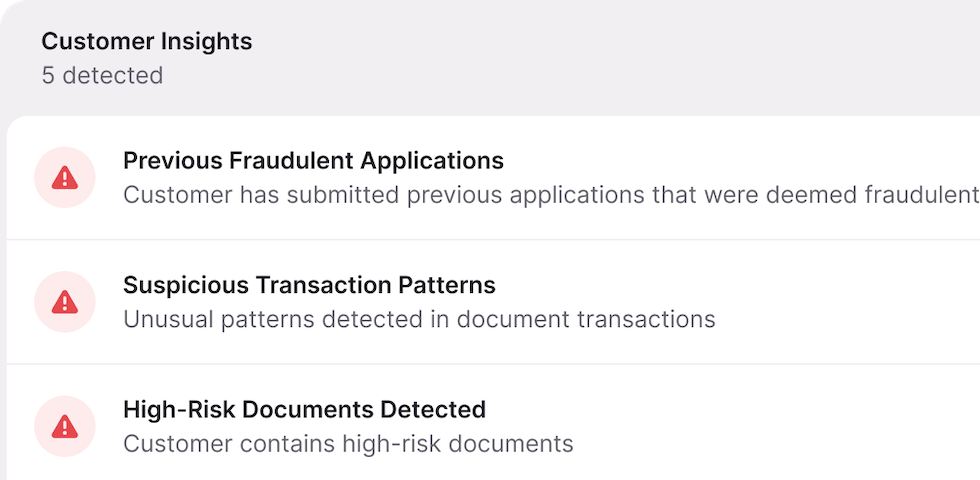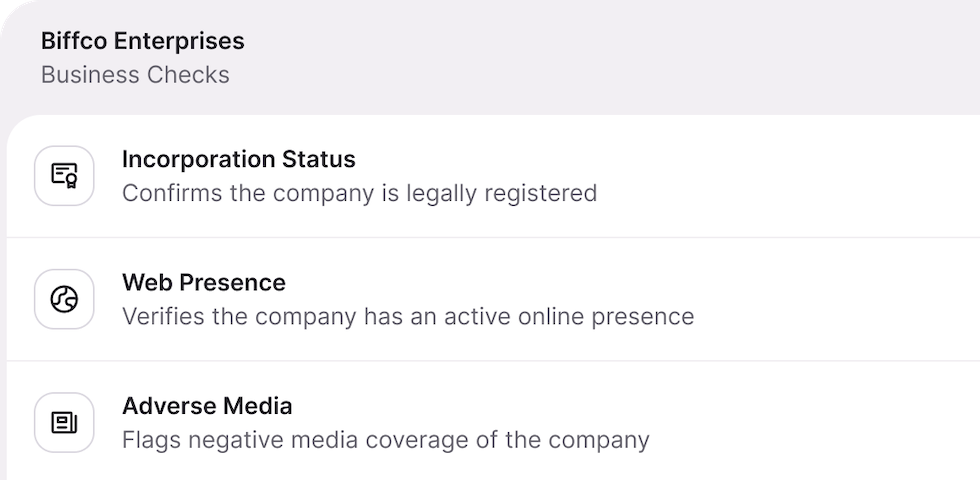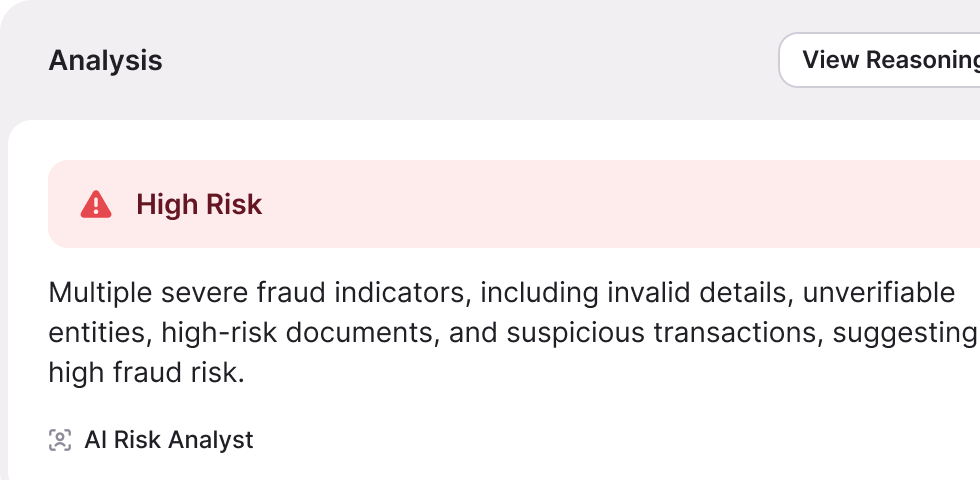Detect forged and deepfake documents with agentic AI
Cut manual reviews by up to 90%, catch more fraud, and get clear, audit-ready decisions. Inscribe doesn't just automate tasks — our AI Agents work alongside your team as intelligent sidekicks, giving analysts the speed, clarity, and confidence to stay ahead of fraudsters.
Switch to your desktop to see the interactive product tour.
Gain a deep understanding of financial documents
Inscribe spots the subtle manipulation patterns and inconsistencies that slip past traditional systems. Our AI Agents don’t just extract data — they understand context, adapt to new tactics, and explain their findings, helping you reduce fraud losses while speeding up legitimate approvals.

Uncover every document’s unique fingerprint
By applying layered detection techniques, our agentic AI exposes fraud hidden in plain sight, including documents generated or edited with AI:
Network detection
Fraudsters often reuse the same playbook. Network detection taps into our vast library of genuine and fraudulent documents to spot recycled templates, suspicious layouts, and repeat patterns, ensuring fraud that’s worked before won’t work again.
Semantic detection
Looks can deceive, but the details rarely lie. Semantic detection cross-checks names, addresses, employment, and income to expose contradictions that don’t add up, helping you separate trustworthy applications from risky ones.
Forensic detection
Every document carries a digital fingerprint. Forensic detection analyzes structure, fonts, metadata, and file history to uncover tampering and synthetic files that manual review often misses, giving you confidence in every approval.
Perceptual detection
Some fraud hides in the smallest details. Perceptual detection examines documents at the pixel level to reveal edits, AI-generated artifacts, and subtle visual inconsistencies, so even the most convincing fakes don’t slip through.

Understand risk at a glance
Inscribe's AI Agents turn complex document analysis into plain-language insights, giving your team clear, defensible explanations without digging through raw data. That means faster reviews and decisions you can stand behind.

Automate repetitive document tasks
From parsing and classification to document collection, Inscribe handles the tedious, manual document review work. Your team gets more time for complex investigations and less fatigue from repetitive tasks.

Get stronger detection over time
With every review, Inscribe’s agentic AI learns from your analysts and our in-house risk analysts. The result? Sharper detection, fewer false positives, and a system that continuously adapts to new fraud tactics.
Connect the dots across documents for full applicant context
Document understanding is just the beginning. Inscribe’s AI Agents expand each investigation beyond the document itself, combining findings with external signals and third-party data to give you a complete, connected view of risk.

Verify applicant details in seconds
Inscribe’s AI Agents instantly confirm employment, validate addresses, and uncover related entities, eliminating manual lookups and copy-paste workflows so your team saves time and reduces errors.

Run KYB checks automatically
Our AI Agents streamline compliance reviews by verifying incorporation status via Secretary of State records, confirming web presence, and surfacing adverse media. That means faster onboarding and stronger compliance, without the manual burden.

See the complete risk picture
By combining document-level reasoning with applicant-level insights, Inscribe’s AI Agents deliver clear, connected risk profiles, helping your team make faster, more confident decisions with all the context in one place.
How Inscribe works
Inscribe’s AI Agents review each document with the depth and judgment of a fraud analyst, but with the added speed, scale, and precision to catch hidden signals humans can’t see.
Screens
The moment a document enters your workflow (via the Collect portal, web app, or API), Inscribe pre-screens it for format validity, completeness, and type accuracy, so bad files are filtered out before they slow you down.
Validates
AI Agents enrich investigations with live research, verifying employers, cross-checking addresses, and linking external sources to document claims, giving you confidence in every detail.
Detects
LLMs extract key fields and check formatting and logic, while advanced detectors uncover hidden fraud vectors. Inscribe also surfaces risks related to transaction or balance details based on rules you configure.
Detects
LLMs extract key fields and check formatting and logic, while advanced detectors uncover hidden fraud vectors. Inscribe also surfaces risks related to transaction or balance details based on rules you configure.
Validates
AI Agents enrich investigations with live research, verifying employers, cross-checking addresses, and linking external sources to document claims, giving you confidence in every detail.
Explains
All findings are translated into a plain-language risk summary with linked evidence and contextual scoring, so your team can make faster, more confident, and defensible decisions.
Logix Federal Credit Union prevented $3M in losses with Inscribe
Challenges
Logix’s investigators struggled to keep up with rising document fraud, as manual verification methods proved too slow and unreliable against increasingly sophisticated fakes.
Solution
Inscribe automates document verification by flagging fraud, validating details, and removing the need for investigators to manually cross-check statements, balances, and employers.

Manager, Fraud Risk Management

2025 Document Fraud Report
See what fraud tactics you need to be aware of to protect your business from avoidable fraud and credit losses.

What will Inscribe find in your documents?
Start your free trial to catch more fraud, faster.
FAQs

What are Inscribe’s AI Agents?
Inscribe’s AI Agents are pre-trained AI coworkers built to fight document fraud and assess risk. They automate tedious reviews, uncover hidden fraud attempts, and streamline onboarding and underwriting tasks so your team can increase outputs without increasing budget, resources, or headcount.

How do Inscribe’s AI Agents detect and assess risk?
Our AI Agents analyze data from multiple sources — including application documents, transaction histories, and external records — to identify patterns, anomalies, and fraud signals. They combine layered document forensics with applicant-level research to spot potential risks before they cause losses.

How do Inscribe’s AI Agents reduce manual document review?
By automating parsing, classification, and verification tasks, our AI Agents cut manual document review by up to 90%, freeing your team to focus on complex investigations and higher-value analysis.

What types of fraud can Inscribe detect?
Inscribe’s AI Agents can detect document forgery, synthetic identities, manipulated income statements, fake employment records, AI-generated forgeries, and suspicious applicant patterns that often bypass legacy, rules-based systems.

Do Inscribe’s AI Agents explain their decisions?
Yes. Inscribe generates plain-language, audit-ready explanations with linked evidence. This ensures fraud, risk, and compliance teams can easily understand and defend decisions.

What industries benefit from Inscribe’s AI Agents?
Banks, lenders, credit unions, property managers, fintechs, and e-commerce companies all use Inscribe to fight fraud, improve compliance, and accelerate onboarding decisions.

What use cases can Inscribe’s AI Agents support?
Our AI Agents are effective across workflows like business underwriting, consumer lending, mortgage lending, KYB, KYC, and fraud detection during onboarding.

How do Inscribe’s AI Agents contribute to compliance?
Inscribe’s AI Agents monitor activities for adherence to regulatory standards, flag potential violations, and generate clear documentation. This helps organizations maintain compliance and avoid penalties.

Can Inscribe’s AI Agents adapt to new fraud tactics and risks?
Yes. Inscribe continuously learns from new data, analyst feedback, and insights from our in-house Risk Ops team. This keeps our AI Agents sharp against evolving fraud and emerging risks.

How do Inscribe’s AI Agents provide actionable insights?
They generate plain-language reports, alerts, and recommendations based on real-time analysis of documents and applicant data. This enables faster, more informed decision-making.

How quickly can we go live with Inscribe?
Inscribe is designed for rapid deployment. Our AI Agents integrate seamlessly into existing workflows so teams can launch quickly — unlike legacy systems that take months to implement.

How does Inscribe impact ROI?
By reducing fraud losses, accelerating approvals, and automating manual reviews, Inscribe helps businesses improve efficiency, protect revenue, and maximize ROI.

How does Inscribe ensure data privacy and security?
Inscribe is SOC 2 and ISO 27001 certified. We encrypt and store all data securely within our Virtual Private Cloud (VPC), and we never send personally identifiable information (PII) to external models.

What support does Inscribe provide to customers?
We offer comprehensive support through onboarding, training, customer success, and ongoing consultation to help teams integrate AI Agents effectively and get the most value from Inscribe.





